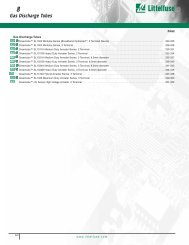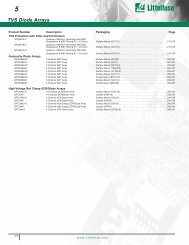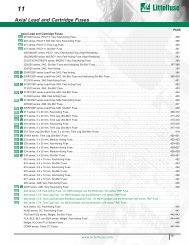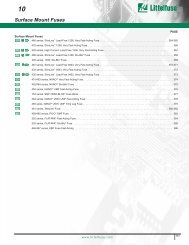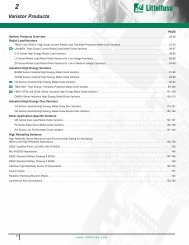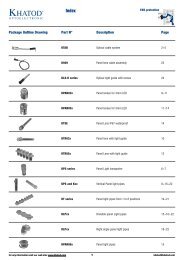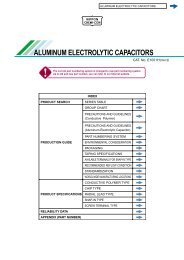Introduction to Circuit Protection
Introduction to Circuit Protection
Introduction to Circuit Protection
Create successful ePaper yourself
Turn your PDF publications into a flip-book with our unique Google optimized e-Paper software.
<strong>Introduction</strong> <strong>to</strong> <strong>Circuit</strong> <strong>Protection</strong><br />
Fuseology<br />
Fuse Facts and Fuse Selection Guide<br />
DERIVATION OF NOMINAL MELTING I 2 t: Labora<strong>to</strong>ry tests are<br />
conducted on each fuse design <strong>to</strong> determine the amount of energy<br />
required <strong>to</strong> melt the fusing element. This energy is described as nominal<br />
melting I 2 t and is expressed as “Ampere Squared Seconds” (A 2 Sec.). A<br />
pulse of current is applied <strong>to</strong> the fuse, and a time measurement is taken<br />
for melting <strong>to</strong> occur. If melting does not occur within a short duration of<br />
about 8 milliseconds (0.008 seconds) or less, the level of pulse current is<br />
increased. This test procedure is repeated until melting of the fuse<br />
element is confined <strong>to</strong> within about 8 milliseconds. The purpose of this<br />
FUSE SELECTION GUIDE<br />
Many of the fac<strong>to</strong>rs involved with fuse selection are listed below:<br />
Selection Fac<strong>to</strong>rs<br />
1. Normal operating current<br />
2. Application voltage (AC or DC)<br />
3. Ambient temperature<br />
4. Overload current and length of time in which the fuse must open.<br />
5. Maximum available fault current<br />
6. Pulses, Surge Currents, Inrush Currents, Start-up Currents, and<br />
<strong>Circuit</strong> Transients<br />
7. Physical size limitations, such as length, diameter, or height<br />
8. Agency Approvals required, such as UL, CSA, VDE, METI, MITI<br />
or Military<br />
9. Considerations: mounting type/form fac<strong>to</strong>r, ease of removal, axial<br />
leads, visual indication, etc.<br />
10. Fuseholder features: clips, mounting block, panel mount, p.c. board<br />
mount, R.F.I. shielded, etc.<br />
NORMAL OPERATING CURRENT: The current rating of a fuse is<br />
typically derated 25% for operation at 25°C <strong>to</strong> avoid nuisance blowing.<br />
For example, a fuse with a current rating of 10A is not usually recommended<br />
for operation at more than 7.5A in a 25°C ambient. For<br />
additional details, see RERATING in the previous section and<br />
AMBIENT TEMPERATURE below.<br />
VOLTAGE: The voltage rating of the fuse must be equal <strong>to</strong>, or<br />
greater than, the available circuit voltage. For exceptions, see<br />
VOLTAGE RATING.<br />
AMBIENT TEMPERATURE: The current carrying capacity tests of<br />
fuses are performed at 25°C and will be affected by changes in ambient<br />
temperature. The higher the ambient temperature, the hotter the fuse will<br />
operate, and the shorter its life will be. Conversely, operating at a lower<br />
temperature will prolong fuse life. A fuse also runs hotter as the normal<br />
operating current approaches or exceeds the rating of the selected fuse.<br />
Practical experience indicates fuses at room temperature should last<br />
indefinitely, if operated at no more than 75% of catalog fuse rating.<br />
4<br />
www.littelfuse.com<br />
procedure is <strong>to</strong> assure that the heat created has insufficient time <strong>to</strong><br />
thermally conduct away from the fuse element. That is, all of the heat<br />
energy (I 2 t) is used, <strong>to</strong> cause melting. Once the measurements of current<br />
(I) and time (t) are determined, it is a simple matter <strong>to</strong> calculate melting<br />
I 2 t. When the melting phase reaches completion, an electrical arc occurs<br />
immediately prior <strong>to</strong> the “opening” of the fuse element. Clearing<br />
I 2 t = Melting I 2 t + arcing I 2 t. The nominal I 2 t values given in this publication<br />
pertain <strong>to</strong> the melting phase portion of the “clearing” or “opening”.<br />
The application guidelines and product data in this guide are intended <strong>to</strong> provide technical information that will help with application design. Since<br />
these are only a few of the contributing parameters, application testing is strongly recommended and should be used <strong>to</strong> verify performance in the<br />
circuit/application.<br />
CHART SHOWING EFFECT OF AMBIENT TEMPERATURE ON<br />
CURRENT-CARRYING CAPACITY (TYPICAL)<br />
KEY TO CHART:<br />
Curve A: Thin-Film Fuses and 313 Series (.010 <strong>to</strong> .150A)<br />
Curve B: FLAT-PAK ® , TeleLink ® , Nano2® , PICO ® , Blade Terminal and<br />
special purpose and other Leaded and catridge fuses (except<br />
313.010-.150A)<br />
Curve C: Resettable PTC’s<br />
PERCENT OF RATING*<br />
140<br />
120<br />
100<br />
80<br />
60<br />
40<br />
20<br />
A<br />
B<br />
-60°C<br />
-76°F<br />
C<br />
-40°C<br />
-40°F<br />
-20°C<br />
-4°F<br />
25°C<br />
0°C 20°C 40°C 60°C 80°C<br />
32°F 68°F 104°F 140°F 176°F<br />
AMBIENT TEMPERATURE<br />
*Ambient temperature effects are in addition <strong>to</strong> the normal rerating,<br />
see example.<br />
Example: Given a normal operating current of 2.25 amperes in an<br />
application using a 229 series fuse at room temperature, then:<br />
Normal Operating Current<br />
Catalog Fuse Rating =<br />
0.75<br />
2.25 Amperes or<br />
0.75<br />
= 3 Amp Fuse (at 25°C)<br />
A<br />
C<br />
100°C<br />
212°F<br />
B<br />
120°C<br />
248°F




